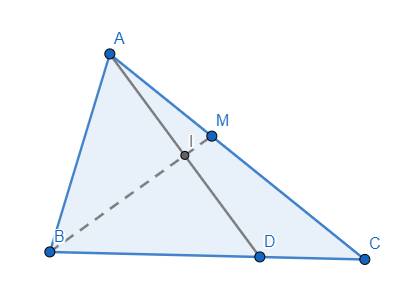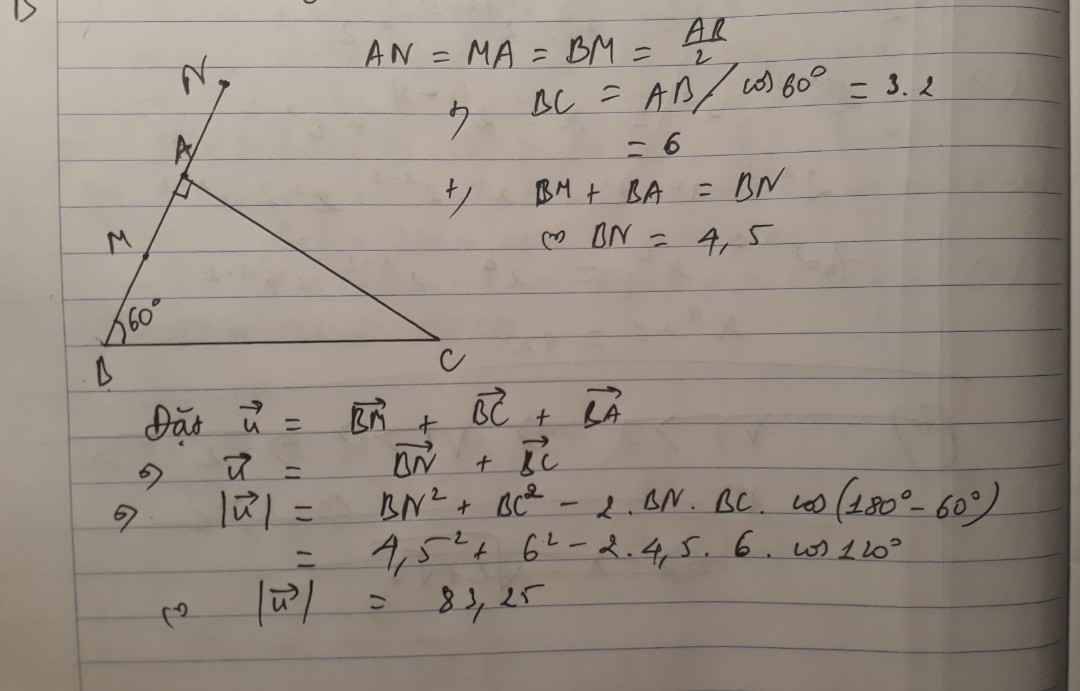Hãy nhập câu hỏi của bạn vào đây, nếu là tài khoản VIP, bạn sẽ được ưu tiên trả lời.

\(\overrightarrow{AM}=\overrightarrow{AB}+\overrightarrow{BM}=\overrightarrow{AB}+\dfrac{2}{5}\overrightarrow{BC}\)

\(\overrightarrow{KA}=-\overrightarrow{AK}=-\frac{1}{2}\left(\overrightarrow{AM}+\overrightarrow{AN}\right)=-\frac{1}{2}\left(\frac{1}{2}\overrightarrow{AB}+\frac{1}{3}\overrightarrow{AC}\right)\)
\(=-\frac{1}{4}\overrightarrow{AB}-\frac{1}{6}\overrightarrow{AC}\)
\(\overrightarrow{KD}=\overrightarrow{AD}-\overrightarrow{AK}=\overrightarrow{AD}+\overrightarrow{KA}=\frac{1}{2}\left(\overrightarrow{AB}+\overrightarrow{AC}\right)-\frac{1}{4}\overrightarrow{AB}-\frac{1}{6}\overrightarrow{AC}\)
\(=\frac{1}{4}\overrightarrow{AB}+\frac{1}{3}\overrightarrow{AC}\)

Xét ΔBAD có BI là đường trung tuyến
nên \(\overrightarrow{BI}=\dfrac{1}{2}\left(\overrightarrow{BA}+\overrightarrow{BD}\right)\)
=>\(\overrightarrow{BI}=\dfrac{1}{2}\left(\overrightarrow{BA}+\dfrac{2}{3}\overrightarrow{BC}\right)\)
\(=\dfrac{1}{2}\left(\overrightarrow{BA}+\dfrac{2}{3}\overrightarrow{BA}+\dfrac{2}{3}\overrightarrow{AC}\right)\)
\(=\dfrac{1}{2}\left(\dfrac{5}{3}\overrightarrow{BA}+\dfrac{2}{3}\overrightarrow{AC}\right)\)
\(=\dfrac{1}{2}\cdot\dfrac{1}{3}\left(5\overrightarrow{BA}+2\overrightarrow{AC}\right)=\dfrac{1}{6}\left(5\overrightarrow{BA}+2\overrightarrow{AC}\right)=\dfrac{5}{6}\left(\overrightarrow{BA}+\dfrac{2}{5}\overrightarrow{AC}\right)\)
\(\overrightarrow{BM}=\overrightarrow{BA}+\overrightarrow{AM}\)
\(=\overrightarrow{BA}+\dfrac{2}{5}\overrightarrow{AC}\)
=>\(\overrightarrow{BI}=\dfrac{5}{6}\cdot\overrightarrow{BM}\)
=>B,I,M thẳng hàng

Cách 1: Dùng định lý Menelaus đảo:

Từ đề bài, ta có \(\dfrac{BD}{BC}=\dfrac{2}{3}\), \(\dfrac{MC}{MA}=\dfrac{3}{2}\), \(\dfrac{IA}{ID}=1\)
\(\Rightarrow\dfrac{BD}{BC}.\dfrac{MC}{MA}.\dfrac{IA}{ID}=1\)
Theo định lý Menelaus đảo, suy ra B, I, M thẳng hàng.
Cách 2: Dùng vector
Ta có \(\overrightarrow{BI}=\dfrac{1}{2}\left(\overrightarrow{BA}+\overrightarrow{BD}\right)\)
\(=\dfrac{1}{2}\overrightarrow{BA}+\dfrac{1}{2}.\dfrac{2}{3}\overrightarrow{BC}\)
\(=\dfrac{1}{2}\overrightarrow{BA}+\dfrac{1}{3}\overrightarrow{BC}\)
\(=\dfrac{1}{6}\left(3\overrightarrow{BA}+2\overrightarrow{BC}\right)\)
Lại có \(\overrightarrow{BM}=\dfrac{MC}{AC}\overrightarrow{BA}+\dfrac{MA}{AC}\overrightarrow{BC}\)
\(=\dfrac{3}{5}\overrightarrow{BA}+\dfrac{2}{5}\overrightarrow{BC}\)
\(=\dfrac{1}{5}\left(3\overrightarrow{BA}+2\overrightarrow{BC}\right)\)
\(=\dfrac{6}{5}.\dfrac{1}{6}\left(3\overrightarrow{BA}+2\overrightarrow{BC}\right)\)
\(=\dfrac{6}{5}\overrightarrow{BI}\)
Vậy \(\overrightarrow{BM}=\dfrac{6}{5}\overrightarrow{BI}\), suy ra B, I, M thẳng hàng.

ta có \(\overrightarrow{AM}=4.\overrightarrow{MC}\)
\(\overrightarrow{BM}=\overrightarrow{BA}+\overrightarrow{AM}\)
\(\Leftrightarrow\overrightarrow{BM}=\overrightarrow{BA}+4.\overrightarrow{MC}\)
\(\Leftrightarrow\overrightarrow{BM}=\overrightarrow{BA}+4.\overrightarrow{MB}+4.\overrightarrow{BC}\)
\(\Leftrightarrow\overrightarrow{BM}=\overrightarrow{BA}-4.\overrightarrow{BM}+4.\overrightarrow{BC}\)
\(\Rightarrow\overrightarrow{BM}=\dfrac{1}{5}\overrightarrow{BA}+\dfrac{4}{5}\overrightarrow{BC}\) (đpcm)
b)còn cái này dùng hàm cos thì phải tính từ từ là ra